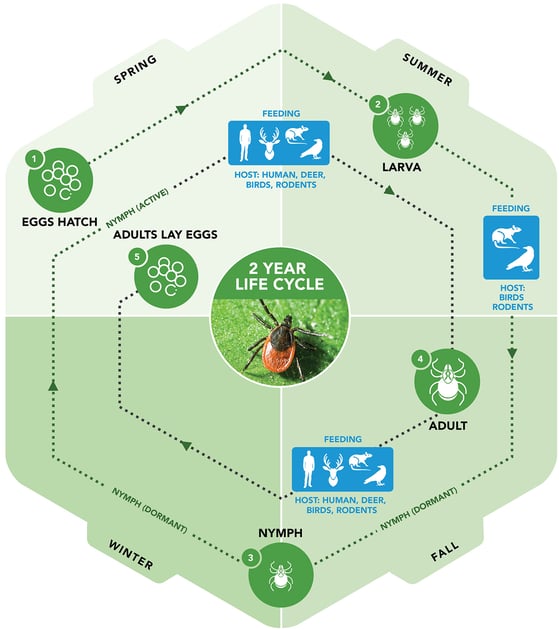Many of us must now accept that ticks are part of our lives when enjoying the outdoors.
By now most people are aware that in May, June, and July ticks are out in force and looking for hosts to feed on. But the reality is that you are at risk of a tick bite almost year-round, depending on your climate.
In this post, we are focusing on the Blacklegged Tick (or Deer Tick, Ixodes scapularis) which spread Lyme Disease throughout the northeastern, mid-Atlantic, and north-central United States.
The life-cycle stages of Deer Ticks goes from Egg > Larva > Nymph > Adult and at each stage, there are ways to help better protect yourself from tick-borne illnesses. Let’s review the life-cycle of a tick.
Egg
In early spring ticks begin to lay their eggs. Ticks are not able to lay eggs directly on a host, they must first detach. However, they can lay eggs just about anywhere else and they do; inside or out ticks love a warm environment to lay their eggs.
After a two-year life cycle, a female tick can lay thousands of eggs. Eggs are not dangerous and appear as a brownish-red translucent color. If you spot eggs you can put salt on them or contact your local natural pest control provider to treat the area. By monitoring the areas ticks like to lay eggs you can remove these populations before they hatch.
Larvae
The eggs laid by an adult deer tick in the spring hatch into larvae later in the summer, their activity peaks around late August. Deer tick larvae are no bigger than a poppy seed and they sit searching out a host such as a mouse, chipmunk or bird to latch onto. Once the larva is attached it will feed for a few days, engorging itself and eventually swelling up with blood. The larva will become infected with Lyme Disease if the host is already infected. Hosts with Lyme Disease (primarily white-footed mice, which are found all over the East Coast) are animal reservoirs, infecting ticks that feed upon them.
Incredibly ticks are “...generally born uninfected with Lyme disease” (https://lymediseaseassociation.org/). It is the animal “reservoirs” that infect the ticks. Once the larva has fed it will not search for another host until after it reaches the next life-cycle stage.
Nymph
Moving from summer to fall Deer Ticks begin to change from larvae to nymphs, this process can last from fall to winter. Because ticks are inactive in colder temps, you are less likely to get a tick bite in the winter months. The nymph deer tick will sit dormant on the forest floor or even nest on a host without feeding. However, stay vigilant if you are outdoors and temps warm up because ticks can (and will) become active the temps warm-up.
The deer tick finally feeds again in Spring, as a nymph. If the nymph is infected with Lyme Disease it can infect whatever it feeds upon - human, pet, wild animal. Nymphs usually have a higher rate of Lyme Disease because of its small size, which makes it a real challenge to spot.
The deer tick nymph feeds by “questing”. “While questing, ticks hold onto leaves and grass with their third and fourth pair of legs. They hold the first pair of legs outstretched, waiting to climb on to the host. When a host brushes the spot where a tick is waiting, it quickly climbs aboard. Some ticks will attach quickly and others will wander, looking for places like the ear, or other areas where the skin is thinner.” (cdc.gov)
If a nymph was not infected with Lyme Disease during its larval stage, it could still become infected from a host at the nymph stage. This is why you must wear light-colored clothing, cover exposed skin as much as possible and stay diligent in checking your body and clothing after recreating outdoors. You must also inspect your children and pets closely. Consult your veterinarian to see what products are available to keep ticks off your pets. You may also want to consider a tick control treatment from a local provider, we recommend utilizing a company that specializes in all natural tick control services.
Adult
Now that the nymph deer tick has fed it will fall off its host and develop into an adult tick throughout the fall, in its adult life cycle stage it will again look for a host to feed on for its third (and final) feeding.
After the adult deer tick completes its last feed, they start mating or nesting (depending on the time of year and weather). While males typically die after mating, females will reproduce by laying thousands of eggs during the spring months as we mentioned above and die shortly after that.
Here are some tips to steer clear of ticks this spring:
- When walking on a trail or path try to stay in the middle of the trail where it is open to avoid any unwanted contact with lurking ticks.
- After an outing outdoors you should always check your body for ticks. Finding and removing a tick quickly can greatly reduce your chances of being infected with a tick-borne disease.
- If you find a tick on you follow these instructions to remove the tick. Also, learn about the tick keys, such as the ones we distribute to our clients.
- If possible, try to save the tick in a jar to identify the tick and submit it for testing.
- Look for natural tick repellents to apply to your clothing before recreating outdoors.
- Get an early start on treating your yard with organic, routine tick sprays for your yard from Pure Solutions. This will help reduce the population of adult deer ticks that survived the winter, preventing them from laying eggs on your property. Our all-natural, organic solution is a tick spray engineered from botanical oils. It has been proven to be safer for use around kids, pets and the environment. Our proven solution has over 10 years of effective results in mosquito and tick extermination.



